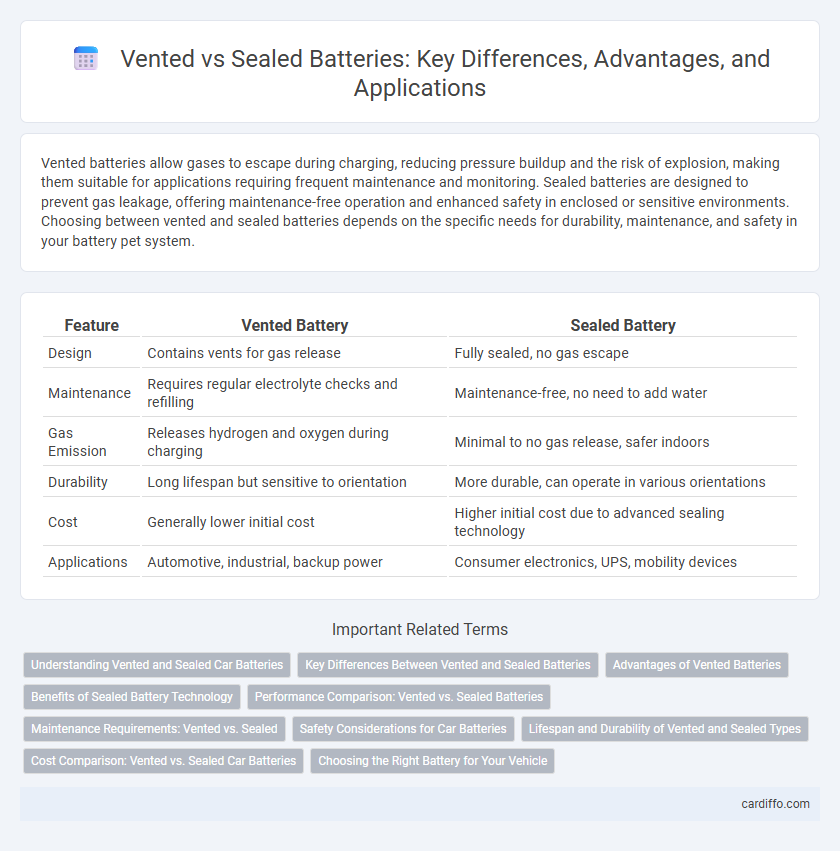Vented batteries allow gases to escape during charging, reducing pressure buildup and the risk of explosion, making them suitable for applications requiring frequent maintenance and monitoring. Sealed batteries are designed to prevent gas leakage, offering maintenance-free operation and enhanced safety in enclosed or sensitive environments. Choosing between vented and sealed batteries depends on the specific needs for durability, maintenance, and safety in your battery pet system.
Table of Comparison
| Feature | Vented Battery | Sealed Battery |
|---|---|---|
| Design | Contains vents for gas release | Fully sealed, no gas escape |
| Maintenance | Requires regular electrolyte checks and refilling | Maintenance-free, no need to add water |
| Gas Emission | Releases hydrogen and oxygen during charging | Minimal to no gas release, safer indoors |
| Durability | Long lifespan but sensitive to orientation | More durable, can operate in various orientations |
| Cost | Generally lower initial cost | Higher initial cost due to advanced sealing technology |
| Applications | Automotive, industrial, backup power | Consumer electronics, UPS, mobility devices |
Understanding Vented and Sealed Car Batteries
Vented car batteries feature removable caps that allow gases to escape during charging and discharging, reducing the risk of pressure build-up and improving safety in high-temperature environments. Sealed car batteries, often referred to as Absorbed Glass Mat (AGM) or Gel batteries, are designed to be maintenance-free, with a sealed casing that prevents electrolyte leaks and minimizes evaporation. Choosing between vented and sealed batteries depends on the vehicle's requirements, usage conditions, and maintenance preferences, with sealed batteries offering enhanced durability and vented batteries providing easier maintenance access.
Key Differences Between Vented and Sealed Batteries
Vented batteries feature removable caps that allow hydrogen gas to escape during charging, preventing pressure buildup but requiring regular maintenance to check electrolyte levels. Sealed batteries are designed to recombine gases internally, eliminating the need for water refilling and reducing the risk of spills, making them more maintenance-free and suitable for confined spaces. The key differences lie in their ventilation systems, maintenance requirements, and application environments, with vented batteries often used in industrial settings while sealed batteries are preferred for consumer electronics and automotive uses.
Advantages of Vented Batteries
Vented batteries offer superior heat dissipation and reduced risk of internal pressure buildup, enhancing safety and longevity in high-drain applications. Their design allows for easier maintenance, such as electrolyte topping, which helps extend battery life. These batteries are preferred in industrial and automotive sectors due to their cost-effectiveness and reliable performance under heavy usage.
Benefits of Sealed Battery Technology
Sealed battery technology offers enhanced safety by preventing acid leakage and reducing the risk of corrosion, making it ideal for enclosed or mobile applications. These batteries require minimal maintenance due to their valve-regulated design that controls internal gas pressure. Their compact and robust construction ensures reliable performance in extreme conditions and extends overall battery lifespan.
Performance Comparison: Vented vs. Sealed Batteries
Vented batteries offer superior heat dissipation and are better suited for high-drain applications due to their ability to release gases safely during charging and discharging cycles. Sealed batteries, also known as valve-regulated lead-acid (VRLA) batteries, provide maintenance-free operation and reduced risk of acid spills, making them ideal for enclosed or sensitive environments. Performance-wise, vented batteries deliver higher peak currents and longer life in demanding conditions, while sealed batteries excel in convenience, safety, and installation flexibility.
Maintenance Requirements: Vented vs. Sealed
Vented batteries require regular maintenance such as checking electrolyte levels and topping off distilled water to prevent damage and ensure optimal performance. Sealed batteries are maintenance-free, designed to prevent electrolyte loss and eliminate the need for water refilling. This makes sealed batteries more convenient for applications where low upkeep is essential.
Safety Considerations for Car Batteries
Vented car batteries allow gases to escape, reducing the risk of pressure buildup but require proper ventilation to prevent explosive gas accumulation. Sealed batteries, also known as maintenance-free, contain gases internally, minimizing acid leakage and corrosion hazards while offering enhanced protection against spills and environmental damage. Choosing between vented and sealed batteries involves balancing ventilation needs and safety during handling, charging, and operation to ensure optimal performance and accident prevention.
Lifespan and Durability of Vented and Sealed Types
Vented batteries offer superior heat dissipation, which enhances lifespan in high-temperature or heavy-load conditions but require regular maintenance to prevent electrolyte loss. Sealed batteries feature a maintenance-free design with sealed valves that reduce the risk of leakage and corrosion, improving durability in varied environments. While vented batteries excel in longevity under demanding use, sealed batteries provide consistent performance with greater resistance to environmental damage.
Cost Comparison: Vented vs. Sealed Car Batteries
Vented car batteries generally cost less upfront than sealed batteries due to their simpler manufacturing process and materials. Sealed batteries, which offer enhanced safety and lower maintenance requirements, tend to have a higher initial price but can reduce long-term expenses related to electrolyte refills and ventilation system upkeep. When comparing cost-effectiveness, vented batteries may be more budget-friendly initially, whereas sealed batteries provide better value over the lifespan of the battery.
Choosing the Right Battery for Your Vehicle
Selecting the right battery for your vehicle involves understanding the differences between vented and sealed types to match performance needs and maintenance preferences. Vented batteries, often known as flooded batteries, provide excellent cycling capability and are easier to service but require regular water refilling to prevent damage. Sealed batteries, including AGM and gel types, offer spill-proof designs, better resistance to vibration, and lower maintenance, making them ideal for modern vehicles with high electrical demands.
Vented vs Sealed Infographic

 cardiffo.com
cardiffo.com